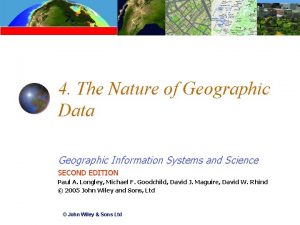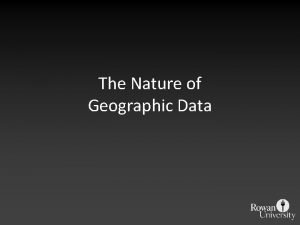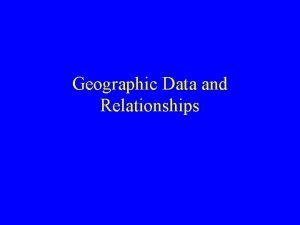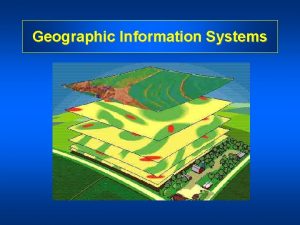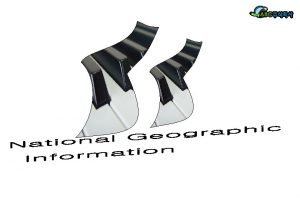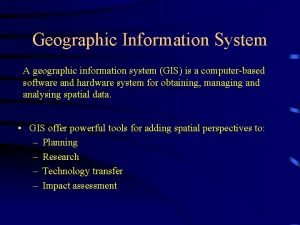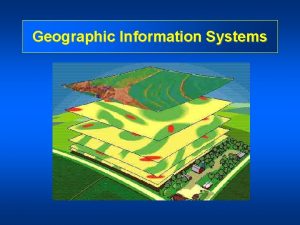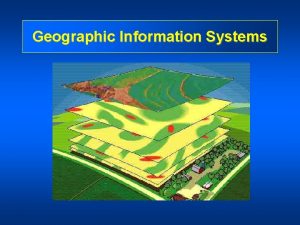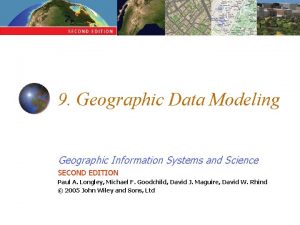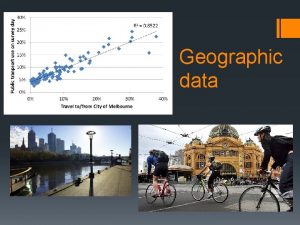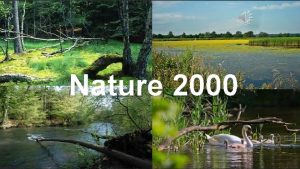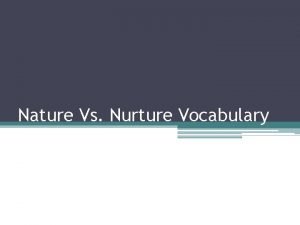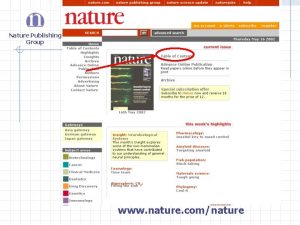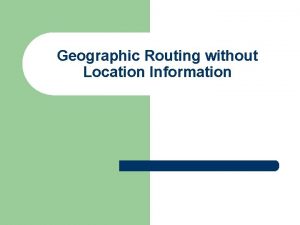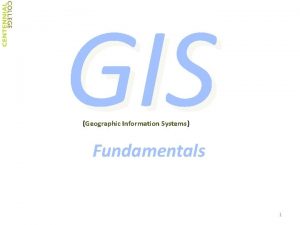4 The Nature of Geographic Data Geographic Information


















- Slides: 18

4. The Nature of Geographic Data Geographic Information Systems and Science SECOND EDITION Paul A. Longley, Michael F. Goodchild, David J. Maguire, David W. Rhind © 2005 John Wiley and Sons, Ltd © John Wiley & Sons Ltd

Overview: Spatial is Special The 'true' nature of geographic data The special tools needed to work with them How we sample and interpolate (gaps) What is spatial autocorrelation, and how can it be measured? Fractals and geographic representation © 2005 John Wiley & Sons, Ltd

Why GIS? Small things can be intricate GIS can: Identify structure at all scales Show spatial and temporal context affects what we do Allows generalization and accommodates error Accommodates spatial heterogeneity © 2005 John Wiley & Sons, Ltd

Building Representations Temporal and spatial autocorrelation Understanding scale and spatial structure How to sample How to interpolate between observations Object dimensions Natural vs. artificial units © 2005 John Wiley & Sons, Ltd

Spatial Autocorrelation Spatial autocorrelation is determined both by similarities in position, and by similarities in attributes Sampling interval Self-similarity © 2005 John Wiley & Sons, Ltd

© 2005 John Wiley & Sons, Ltd

Spatial Sampling Sample frames Probability of selection All geographic representations are samples Geographic data are only as good as the sampling scheme used to create them © 2005 John Wiley & Sons, Ltd

Sample Designs Types of samples Random samples Stratified samples Clustered samples Weighting of observations © 2005 John Wiley & Sons, Ltd

© 2005 John Wiley & Sons, Ltd

Spatial Interpolation Specifying the likely distance decay linear: wij = -b dij negative power: wij = dij-b negative exponential: wij = e-bdij Isotropic and regular – relevance to all geographic phenomena? Inductive vs. deductive approaches © 2005 John Wiley & Sons, Ltd

Spatial Autocorrelation Measures Spatial autocorrelation measures: Moran; nature of observations Establishing dependence in space: regression analysis Y = f (X 1, X 2 , X 3 , . . . , XK) + ε Yi = f (Xi 1, Xi 2 , Xi 3 , . . . , Xi. K) + εi Yi = b 0 + b 1 Xi 1 + b 2 Xi 2 + b 3 Xi 3 +. . . b. K Xi. K + εi © 2005 John Wiley & Sons, Ltd

© 2005 John Wiley & Sons, Ltd

© 2005 John Wiley & Sons, Ltd

© 2005 John Wiley & Sons, Ltd

© 2005 John Wiley & Sons, Ltd

Functional form The assumptions of inference Tobler’s Law Multicollinearity © 2005 John Wiley & Sons, Ltd

Discontinuous Variation Fractal geometry Self-similarity Scale dependent measurement Regression analysis of scale relations © 2005 John Wiley & Sons, Ltd

Consolidation Induction and deduction Representations build on our understanding of spatial and temporal structures Spatial is special, and geographic data have a unique nature © 2005 John Wiley & Sons, Ltd
 Nature of geographic data
Nature of geographic data The nature of geographic data
The nature of geographic data Nature and nature's laws lay hid in night meaning
Nature and nature's laws lay hid in night meaning Nature nature controversy
Nature nature controversy Types of geographic data
Types of geographic data Hình ảnh bộ gõ cơ thể búng tay
Hình ảnh bộ gõ cơ thể búng tay Frameset trong html5
Frameset trong html5 Bổ thể
Bổ thể Tỉ lệ cơ thể trẻ em
Tỉ lệ cơ thể trẻ em Chó sói
Chó sói Tư thế worm breton
Tư thế worm breton Hát lên người ơi alleluia
Hát lên người ơi alleluia Môn thể thao bắt đầu bằng chữ f
Môn thể thao bắt đầu bằng chữ f Thế nào là hệ số cao nhất
Thế nào là hệ số cao nhất Các châu lục và đại dương trên thế giới
Các châu lục và đại dương trên thế giới Công thức tính độ biến thiên đông lượng
Công thức tính độ biến thiên đông lượng Trời xanh đây là của chúng ta thể thơ
Trời xanh đây là của chúng ta thể thơ Mật thư tọa độ 5x5
Mật thư tọa độ 5x5 Làm thế nào để 102-1=99
Làm thế nào để 102-1=99
